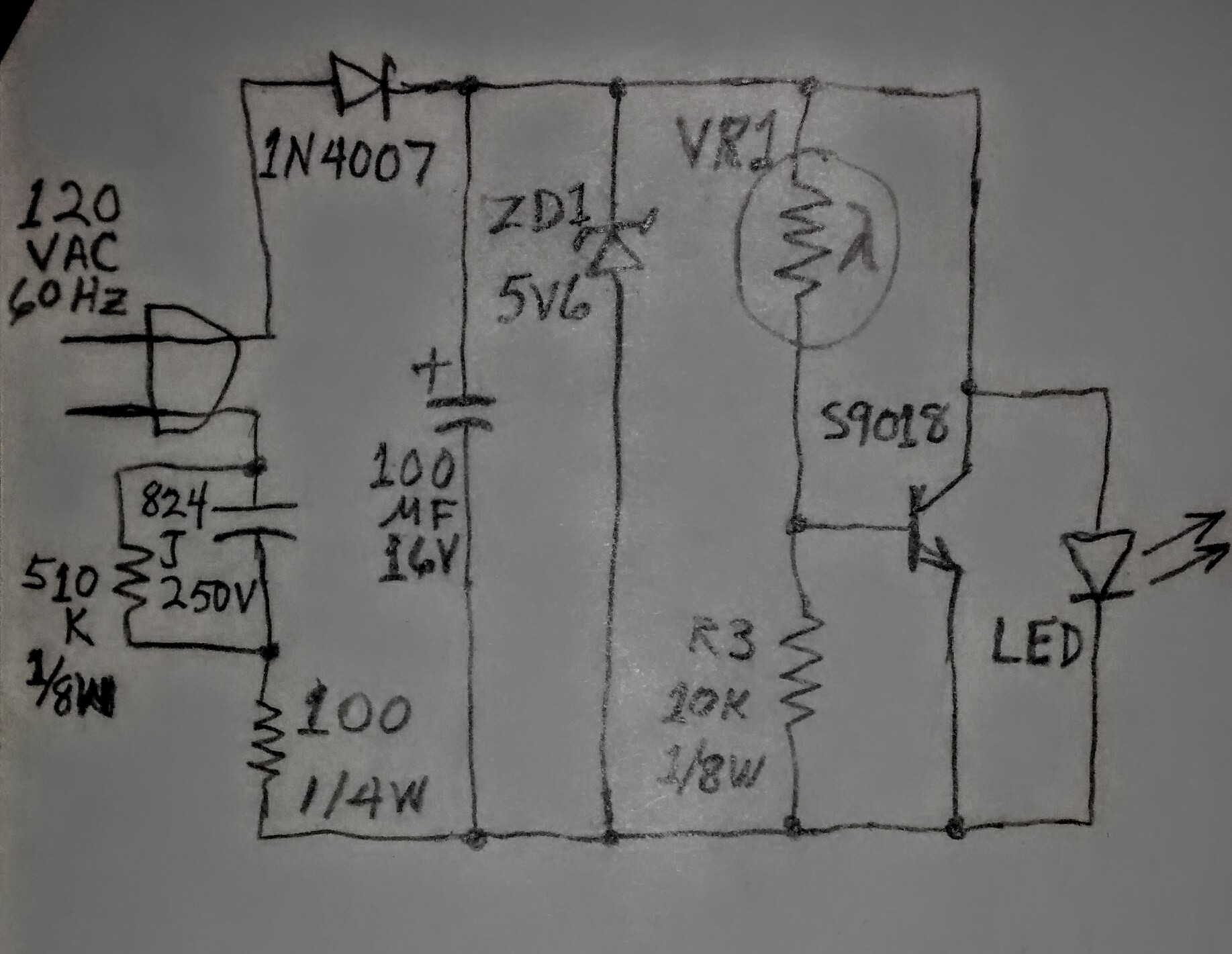I found these at a Walmart store. They’re named Great Value and came in a package of four nightlights. As usual, curiosity made me open it up to see the circuit inside.
I traced the circuit and drew a schematic of it. I was disappointed, but not surprised. The way the CdS photocell works is not what I had hoped for. In the daytime, light hitting the photocell reduces its resistance. The increased current through the photocell turns the transistor on, and the current through the LED instead goes through the transistor, and the LED goes dark.
The point is that this does not save power by turning the LED off and reducing the current. Instead the current from the AC line actually increases slightly while it’s ‘off’ So the nightlight is using the same or more power when the LED is not on. This won’t get an Energy Star efficiency rating, and I give it a poor design rating.
I will say a good thing or two about it. It uses a half watt, which is much less than the 7 watt incandescent nightlight. And because it is a LED, it will last much longer – several years – than the incandescent light. It should more than pay for itself in electricity savings over its lifetime. But it could save much more electricity if it shut completely off instead of shorting out the LED. Another thing is it was inexpensive; four lights for under five dollars.
I also noticed that when I moved my hand in the light, I got the strobe effect of the LED turning on and off at 60 Hz. The circuit schematic shows a 100 uF capacitor that is supposed to filter out the AC, but it is far from adequate to do the job. It would have to be ten times more capacitance to do the job.
Several years ago I traced the circuit of another LED nightlight. It used a photocell and a 555 chip as a comparator, to shut off current to the LED. My guess was that the 555 used a lot of power, perhaps as much as the LED, which used only 20 mA at 3.3 volts, or 66 mW.
One other thought. Why bother to shut off the LED in the daytime? Just let it run all the time and save money by leaving out the parts.
I could remove the photocell, the transistor and the 10k resistor, and it will still work just fine, but it won’t go off during the daytime. That would be okay with me. There may be someone who wants a 5mm diameter photocell, 10k, 1/8W resistor and S9014 NPN transistor for a project, and can remove them without disabling the nightlight.
Update Nov 17 – I opened one up and unsoldered the photocell, now it doesn’t turn off in the daytime, which is what I want it to do. It is going in a light fixture along with a string of lights so th e other lights will no longer cause the photocell to turn off the nightlight. The whole circuit is on a light switch so daylight is not an issue.
On second thought, the circuit does have one positive use. It disables the LED during the daytime, and reduces the time the LED is on, which increases the night light’s longevity, the number of years that it will put out adequate light. The LED’s output diminishes over time: after thousands of hours the LED’s light output slowly drops and eventually the LED becomes too dim to be useful. Not leaving it running all day extends the night light’s lifetime.
One other thing I should mention (I have blogged this in the past) is that devices like this should use a capacitor that is X2 rated. The 0.82 uF (824J) capacitor is not rated X2. Sometimes a capacitor connected to the AC line will get a high voltage spike, and this causes an arc in the dielectric. A regular capacitor may short, causing overheating and a fire. X2 capacitors are made to arc without causing a short, and without overheating or fire. These X2 caps are used in the power supplies of computers and most digital equipment.
